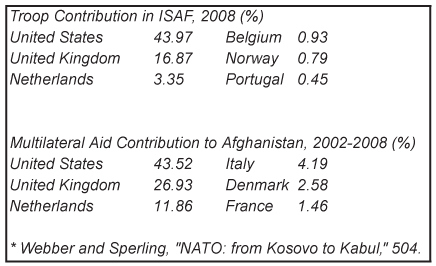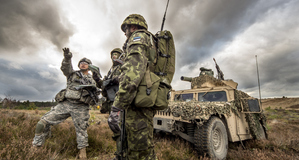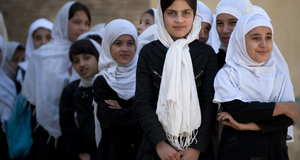From Cornell International Affairs Review VOL. 3 NO. 2NATO's Dilemma: Asset Specificity and the Challenge of Securing Afghanistan
IN THIS ARTICLE
KEYWORDS
On the 60th anniversary of the North Atlantic Treaty Organization's founding, Afghanistan provides a unique opportunity for the alliance to prove its strength beyond Europe and combat global security threats from terrorism and instability.2 But despite proving its early critics such as John Mearsheimer wrong during the 1990s, NATO's credibility is once again on the line – Afghanistan is proving to be a difficult test of the alliance's political will and military capabilities.3 NATO's mission – the International Security Assistance Force (ISAF) has been marred by a lack of collective action amongst its member states and led new critics to claim that NATO has been ‘pushed to the edge of collapse' in yet another crisis.4 Analysts have pointed out to the stark disparity in ISAF troop contribution and financial commitment amongst member states as illustrative of the uneven burden sharing in stabilizing Afghanistan. In this paper, I ask the question: why does the NATO face a problem of weak collective action in Afghanistan? In answering my own query, I will argue that the weakness of collective action in Afghanistan arises from NATO's failure to develop specific assets to deal with the unique security challenges it faces in Afghanistan. In particular, I will show that strategic ambiguity over mission objectives, absence of uniform funding channels and problematic civilian assets combine to raise costs without tangible benefits for contributing members and impede collective action within NATO in the ISAF mission. "We must not—we cannot — become a two-tiered alliance of those who are willing to fight and those who are not. Such a development, with all its implications for collective security, would effectively destroy the Alliance." – US Defense Secretary Robert Gates speaking on NATO in Afghanistan at a 2008 security conference in Munich1 Free-Riding: Evidence from the GroundDespite the fact that shared risk and responsibility is still regarded as a ‘founding principle of NATO,' the ISAF mission in particular presents a classic case of uneven burden sharing. Peter Forster and Steven Cimbala define ‘burden sharing' as "the distribution of costs and risks among members of a group in the process of accomplishing a common goal." The table below illustrates the scenario in Afghanistan:5 Such disparities reflect a choice of ‘selective commitment' by certain member states.6 Joel Hillison highlights such behavior — the inadequate contribution to attainment of the common goal — as evidence of free riding by NATO member states such as Belgium, Italy and Norway amongst others.7 The interdependency of military operations in Afghanistan with civilian tasks of policing and economic reconstruction requires financial and logistical contribution along with military assets; as not all member states contribute in these areas towards NATO's goal of stabilization and reconstruction, free-riding by some proves costly for the alliance as a whole.8 Assets and Collective ActionMancur Olson, in examining collective action, argues that in a group setting "unless the number of individuals in a group is quite small, or unless there is coercion or some special device to make individuals act in their common interest, rational, selfinterested individuals will not act to achieve their common or group interests."9 Despite its current size (with 28 member states), NATO does not appear to be facing institutional problems typically associated with a large scale; Celeste Wallander attributes this to the presence of ‘general assets' within the alliance such as the North Atlantic Council (NAC), a strong civilian staff and established communication channels.10 "The problem with the ISAF strategy papers is that these represent mostly ‘consensus documents' and lack detailed expectations or commitment pledges for each member state" Hence, what Olson refers to as the ‘other special device' is the remaining factor which can explain collective action — or the lack thereof — within the NATO's mission in Afghanistan. Wallander labels these devices as ‘specific assets' which "facilitate particular transactions and confer efficiency gains."11 She argues that in dealing with different sources of instability and threats, alliances need targeted institutional principles, practices and procedures to enable member states to mitigate the security concern. A military threat needs to be addressed with assets that allow the alliance to mount credible defense and, if needed, combat capabilities; dealing with political instability requires assets for mediation and engagement while peacekeeping requires mobile ground forces, multinational command and police-like rules of engagement.12 For ISAF, it currently faces all of these challenges in Afghanistan: there is an acute security threat from the Taliban insurgency, a challenge of reconstructing the weak Afghan economy and it needs to be able to secure a stable and transparent government. As Wallander argues, a responsive institution ensures collective action by addressing these diverse mission needs through constant adaptation and development of new specific assets. I will illustrate that in the context of Afghanistan, NATO has failed to develop such a range of specific assets; its repertoire of general assets facilitate necessary cooperation in Brussels but are not sufficient to address the unique security demands in Kabul. The absence of specific instruments and mechanisms — namely strategic ambiguity, absence of an uniform funding structure and problematic civilian assets — limit the scope and raise costs of contribution to ISAF (such as exposure to combat risks and uncertainty in planning for long term objectives) without providing any discernible and immediate benefit to each member state.13 As a result, member states such as Belgium, Italy and Norway are disincentivized to contribute to the mission objectives which in turn lead to a complex collective action problem. The Case of ISAFWallander shows that with out-of-area missions, NATO's "mission-specific command structure needs to be as mobile as its forces."14 For the ISAF, the failure to develop the specific assets in security and reconstruction operations means that such a responsive structure has not materialized across its five phases of operations since 2001. 15,16 Strategic AmbiguityISAF was originally created by UN Security Council Resolution 1386 in December 2001 with military responsibilities limited to Kabul. In 2003, it assumed full command of ISAF in Afghanistan from the US and by 2008, it was responsible for (i) providing law and order, (ii) promoting governance and development, (iii) helping reform the justice system and (iv) training an Afghan police force and army under UNSCR 1883.17 Within the alliance, NATO has attempted to adapt and internalize these evolving responsibilities by adopting new strategies and declarations: in the 2004 Berlin Agreement, NATO committed itself to ‘sufficiently constitute and [make] operational' Afghan security forces while the 2008 Strategic Vision confirmed NATO's ‘long term commitment' to Afghanistan and shift to a ‘comprehensive civilian-military approach' while increasingly engaging with neighbors, ‘especially Pakistan.'18 The problem with the ISAF strategy papers is that these represent mostly ‘consensus documents' and lack detailed expectations or commitment pledges for each member state (or the means of following up on these). Julianne Smith and Michael Williams label this as NATO's ‘lack of a roadmap'.19 Institutional ambiguity about the scope and objective of the ISAF mission, most importantly at the tactical level, reflects failure on NATO's part to develop a specific asset that can continually define its mission statement. This infuses uncertainty for each member state, making it difficult to plan for long term military and financial contributions and raises the opportunity cost of commitment. For instance, shortly after the 2004 Berlin Agreement, when the US requested ISAF members to assume selected counter-insurgency responsibilities (originally conducted as part of Operation Enduring Freedom (OEF)), some NATO states balked and cited that, despite their Berlin commitments, combat operations were the purview of the US-led OEF and the preceding UN Resolution required ISAF to engage in stabilization operations only.20 With mission statements lacking clarity and defined responsibilities for contributing states, NATO members have no incentive to engage in riskier operations of counter-insurgency and are rather incentivized to free-ride in the complex security environment. Similarly, a 2008 NATO Parliamentary Report cited that several nation states, including Italy and Spain, hold strong to the belief that "the formal responsibilities of the Alliance itself have always centered almost exclusively on one area: the provision of a safe and secure environment." The report continues to state that these states feel that NATO should not have the lead in providing for democratic development, agricultural reform, or literacy programs, which "more appropriately fall under the responsibility of other organizations and agencies." 21 The German Defense Minister went as far as asserting that, "[Even] this [counter-insurgency] is not what the NATO is supposed to do."22 This is problematic in the context of the challenges faced in Afghanistan: stabilization efforts need to be preceded by mitigation of threats from the Taliban insurgency and specific assets, in this case institutional guidelines, are necessary to motivate states to engage in the mission in a comprehensive manner, instead of making ‘selective commitments'. Perhaps the most detrimental outcome of this strategic ambiguity is the national caveats. As of 2008, there were as many as 62 caveats in place for the ISAF mission, which had a ‘direct negative impact' on mission goals in Afghanistan.23 Almost half of the forces in ISAF have some form of caveats. These include ban on nighttime operations, consultation with national governments, exclusion of specific operations (notably, counter insurgency) and even ban on fighting after a snowfall. The lack of a specific institutional guideline (that systematically outlines expectation from member states) means that ISAF ground commanders have had to shape and compromise their conduct of missions to fit the caveats of national troops — instead of member forces adapting to mission-specific requirements mandated by a clear strategy paper. For instance, Germany provides a large number of troops to stabilization efforts (nearly 9 percent), but imposes restrictions on where German troops can be deployed and on rules of engagement.24 In 2006, this led Germany to refuse requests by the US to redeploy to the volatile southeastern region: absence of a well-developed strategic statement as a specific asset means that member states can opt for self-designed restrictions and consequently hamper the operational effectiveness of ISAF. National caveats forfeit NATO's inherent advantage in intelligence, speed, firepower, and other attributes over any adversary in Afghanistan, and therefore put NATO soldiers at higher risk and impose additional costs on contributing members, creating disincentives from acting collectively.25 It is important for the ISAF to swiftly develop a comprehensive and targeted ‘road map' if it is to overcome the current strategic ambiguity in its operations. The New Strategic Concept for NATO — a consensus document on strategies to counter new security challenges and expected to be approved in late 2010 — is one such opportunity for all member states to articulate their commitments to the coalition anew as well as outline expectations of partner states in complex missions such as the ISAF.26 Recent progress on the formulation of this strategy paper, recognizing the importance of securing Afghanistan, provides reasons for optimism. A key part of any redefined Strategy Concept should include a reiteration (or realistic revision) of the alliance's benchmark of military expenditure ‘at 2 percent of GDP' expected of each member state.27 Similarly, the concept of civilian-military counterinsurgency needs to be officially adopted as a key focus for the alliance as a whole, combining military commitment with civilian partnership efforts. Renewed commitment outlined in a strategic agreement is likely to motivate member states to contribute proportionally to the crucial mission in Afghanistan. More importantly, the issue of national caveats needs to be addressed at the tactical level for the ISAF. Any solution would ideally involve a closer level of coordination amongst national force commanders in Kabul who should be granted greater autonomy to exchange information and logistical support in respective mission areas: interaction with military commanders from partner states should be prioritized over relying on directives from civilian bureaucrats in the respective European capitals. Specifically, an asset in the form of an unambiguous mission manual that specifies expectations of military commanders on the ground will be critical in overcoming these national caveats. Recent successes in Operation Moshtarak in Helmand, though largely a US-Afghan effort, signal scopes of interoperability of different member state forces when there is greater tactical clarity and suggest the possibility of correcting problems of national caveats in future missions. Absence of Centralized ISAF BudgetDespite possessing effective general assets, NATO's budget rules appear to perpetuate the inequity in burden sharing, more acutely in high cost and long-term missions such as the one in Afghanistan. When a member state agrees to deploy troops to a NATO operation, that nation is obligated to pay the costs associated with that deployment.28 Thus, there is a built in disincentive for nations to agree to commit troops to a mission or increase the size of forces already deployed. This complicates efforts for ISAF, especially as additional costs have to be borne to counter the current Taliban offensive and the urgency to secure areas for civilian reconstruction projects to start. For many member states, this budgetary obligation imposes significant domestic opportunity costs: one, they have to allocate portions of their national budget towards ISAF and two, leaders of fragile governments or coalition governments often have to expend serious efforts to convince their legislatures and publics to support deployment and the associated costs. A specific asset – in this case, a common operational funding system – could have otherwise minimized the burden on certain member states with unique domestic political (and economic) conditions; reluctant states could have still committed troops while leaving costs of deployment to be funded by a commonly pooled budget. Smith and Williams label the approach of the current funding system as one based on "costs lie where they fall."29 This system deters nations from going ‘first in' for a given operation since they have to bear the high costs of establishing the very facilities to start up in a new theater. For Latvia and Estonia amongst other smaller member states, this is particularly problematic: these start-up expenses are prohibitively high and despite their political willingness to contribute, they are disincentivized to take the lead on establishing new mission bases. During Phases I and II, this left the larger member states with the burden of setting up most facilities as ISAF expanded geographically through Afghanistan. Additionally, these ‘entry costs' (even if borne by a willing ‘first in' member state) arguably leads to reluctance by states to redeploy to a different theater as they become unwilling to leave behind the facilities they originally funded and constructed, often tailored to the specific requirement of their national forces.30 This may partly explain the long time hesitance of Germany to redeploy part of its 3000-member troop contingent to southern Afghanistan despite continued requests by the US and the UK. Having established facilities in northern Afghanistan since the early stages of the ISAF, Germany had no incentive to volunteer or accept request by allies to undertake new operations in the more volatile areas, which could have otherwise benefitted from efforts of a well trained and experienced German contingent. Hence, the absence of common ISAF funding means that states are likely to decide on commitments unilaterally and complicate opportunities to act collectively. US and British armed forces patrol Sangin District area of Helmand Province in Afghanistan as part of the NATO operation. The recent collapse of the Dutch government over whether to extend its mission beyond August 2010 is evidence that the obligation on each member state to bear deployment-related costs remains problematic. To that end, the alliance should ‘rechannelize' its ISAF budget, that is it should develop a centralized funding system for the mission: each partner state should be asked to only contribute proportionally to a Brussels-based NATO budget as per alliance commitments.Continued on Next Page » Suggested Reading from Inquiries Journal
Inquiries Journal provides undergraduate and graduate students around the world a platform for the wide dissemination of academic work over a range of core disciplines. Representing the work of students from hundreds of institutions around the globe, Inquiries Journal's large database of academic articles is completely free. Learn more | Blog | Submit Latest in International Affairs |



















